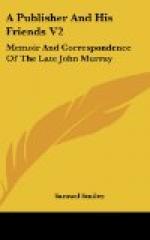Though Mr. Lockhart gave an interesting review of “Isaac Comnenus” in the Quarterly, it still hung fire, and did not sell. A few years later, however, Henry Taylor showed what he could do, as a poet, by his “Philip van Artevelde,” which raised his reputation to the highest point. Moore, after the publication of this drama, wrote in his “Diary”: “I breakfasted in the morning at Rogers’s, to meet the new poet, Mr. Taylor, author of ‘Philip van Artevelde’: our company, besides, being Sydney Smith and Southey. ‘Van Artevelde’ is a tall, handsome young fellow. Conversation chiefly about the profits booksellers make of us scribblers. I remember Peter Pindar saying, one of the few times I ever met him, that the booksellers drank their wine in the manner of the heroes in the hall of Odin, out of authors’ skulls.” This was a sharp saying; but Rogers, if he had chosen to relate his own experiences when he negotiated with Mr. Murray about the sale of Crabbe’s works, and the result of that negotiation, might have proved that the rule was not of universal application.
“The Family Library” has already been mentioned. Mr. Murray had long contemplated a serial publication, by means of which good literature and copyright works might be rendered cheaper and accessible to a wider circle of readers than they had hitherto been.
The Society for the Diffusion of Useful Knowledge was established in 1828, with Henry Brougham as Chairman. Mr. Murray subscribed L10 to this society, and agreed to publish their “Library of Entertaining Knowledge.” Shortly afterwards, however, he withdrew from this undertaking, which was transferred to Mr. Knight, and reverted to his own proposed publication of cheap works.
The first volume of “The Family Library” appeared in April 1829. Murray sent a copy to Charles Knight, who returned him the first volume of the “Library of Entertaining Knowledge.”
Mr. Charles Knight to John Murray.
“We each launch our vessels on the same day, and I most earnestly hope that both will succeed, for good must come of that success. We have plenty of sea-room and need never run foul of each other. My belief is that, in a very few years, scarcely any other description of books will be published, and in that case we that are first in the field may hope to win the race.”
Mr. Murray’s intention was to include in the Library works on a variety of subjects, including History, Biography, Voyages and Travels, Natural History, Science, and general literature. They were to be written by the best-known authors of the day—Sir Walter Scott, Southey, Milman, Lockhart, Washington Irving, Barrow, Allan Cunningham, Dr. Brewster, Captain Head, G.R. Gleig, Palgrave, and others. The collection was headed by an admirable “Life of Napoleon,” by J.G. Lockhart, partly condensed from Scott’s “Life of Napoleon Bonaparte,” and illustrated by George Cruikshank. When Lockhart was first invited to undertake this biography he consulted Sir Walter Scott as to the propriety of his doing so. Sir Walter replied:




